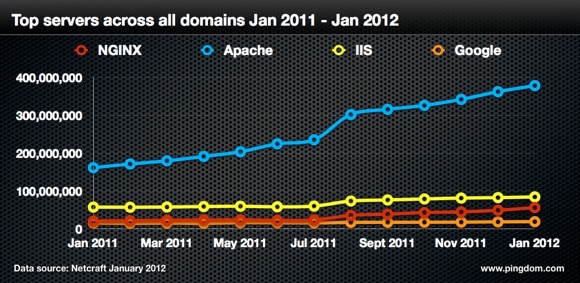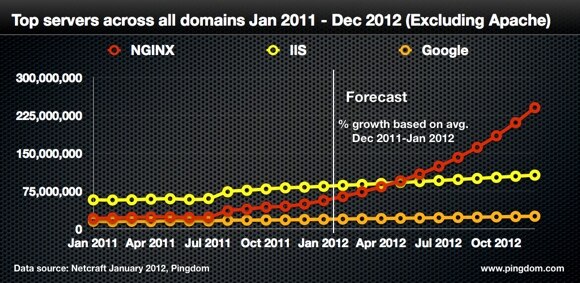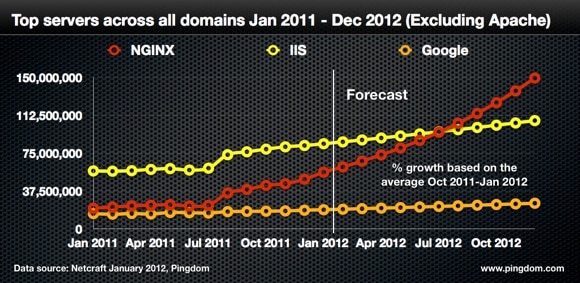
Last week we published an article declaring that NGINX had become the second most used web server software in the world, thereby overtaking Microsoft Internet Information Server (IIS).
In that article, based on figures from Netcraft’s Web Server Survey, we looked at the data for “active sites.” NGINX had in that category pulled ahead of IIS for the first time, even though it was by a slim margin. NGINX accounted for 22,221,514 servers and IIS accounted for 22,142,114.
As we noted then, if you instead look at Netcraft’s “Market Share for Top Servers Across All Domains,” NGINX is still behind IIS. The margin is substantial but closing. We stated that NGINX might take the number two spot even in that category this year.
Now, let’s find out if that can happen and if so, when.
Apache is still number one
If we look at January 2011 to January 2012 for “Market Share for Top Servers Across All Domains,“ we get this chart:

As you can see from the chart above, there was a notable increase in number of sites in July-August 2011. As Netcraft noted, there was a similar increase for all server software, so there was very little change in market shares.
This jump Netcraft explains by “particularly large increases in the number of sites hosted by Softlayer, AmeriNOC, China Telecom, and the social networking communities Tumblr, Skyrock and Hyves.”
In any case, Apache is still the undisputed king of web server software, followed by IIS, NGINX and Google. In fact, Apache is growing faster than the other three.
But our interest here is to look at when, if at all, NGINX may overtake IIS so let’s leave Apache out of the equation for now.
NGINX could overtake IIS by mid-2012
If we take the percentage growth rate that IIS and NGINX, respectively, had between December 2011 and January 2012, and apply that throughout 2012, we get the following chart:

If this comes true, NGINX would overtake IIS somewhere around March or April 2012.
In a more conservative estimate, we took the average monthly percentage growth rate for October 2011 to January 2012, and applied that throughout 2012. As it turns out, this only delays NGINX’s possible overtake by a few months.

Finally, if we take the average monthly percentage growth rate for the entire 2011, and base the estimate for 2012 on that, NGINX will overtake Microsoft’s web server software sometime in July or August 2012.
Is Apache next?
This is of course all forecasting, guessing and conjecture, but it will be interesting to see how things pan out over 2012.
There’s no doubt that the small upstart NGINX has the momentum in the battle for web server software supremacy. We firmly believe that it will bypass IIS sometime during 2012, even in the “all domains” category, the question is just when it will happen.
But after it does, will NGINX set its sights on Apache? That will certainly be a whole other ballgame, and we’ll be following it closely.
Top picture by Robert.
























